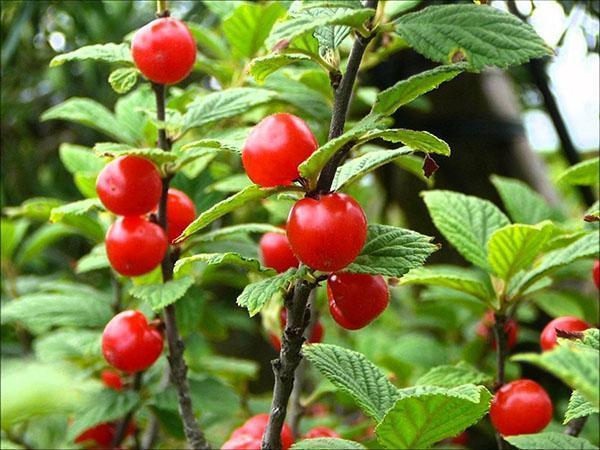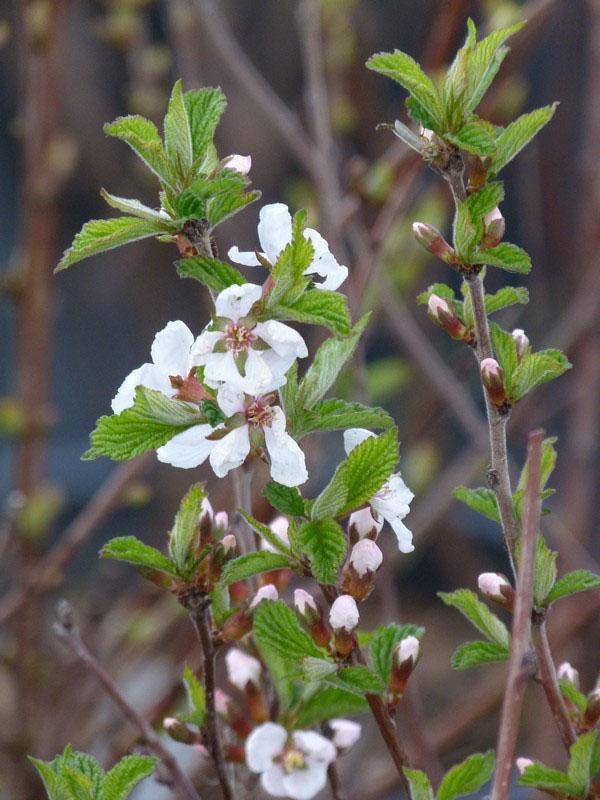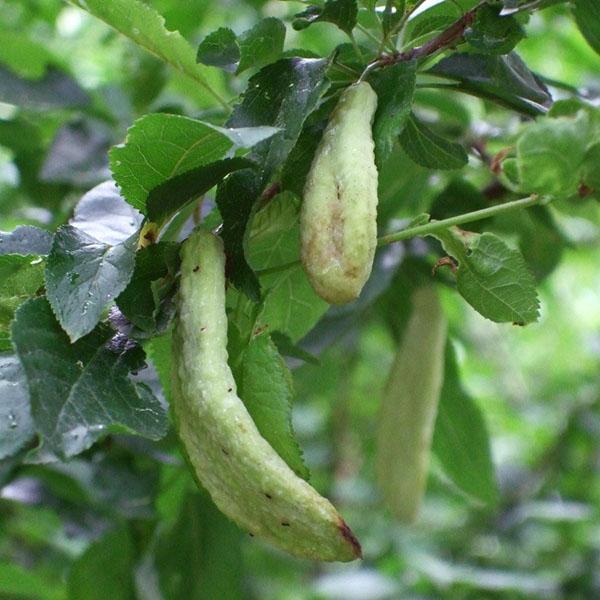Photos with descriptions and methods of treating felt cherry diseases
 Felt cherries are grown today in different climatic zones of the country and are loved by gardeners for their non-capricious disposition, quick entry into the season of fruiting and large yields of sweet, elegant berries. But no matter how unpretentious this culture is, summer residents need to be able to recognize diseases felted cherry, description with photos and methods of treating ailments will help you quickly and effectively cope with the problem.
Felt cherries are grown today in different climatic zones of the country and are loved by gardeners for their non-capricious disposition, quick entry into the season of fruiting and large yields of sweet, elegant berries. But no matter how unpretentious this culture is, summer residents need to be able to recognize diseases felted cherry, description with photos and methods of treating ailments will help you quickly and effectively cope with the problem.
The inhabitants of the Old and New Worlds got acquainted with felt or Chinese mountain cherry at the end of the 19th century. The history of the spread of an interesting fruit culture in Russia began later. The first saplings of amazing cherry trees from the southern regions of the Soviet Far East to the central part of the country were delivered in the pre-war years. At the same time, the first cultivars appeared. But the real popularizer of the felt cherry was IV Michurin. He created varieties adapted to the conditions of most regions of the former USSR.
Modern varieties that can withstand frosts down to -40 ° C, are distinguished by the highest winter hardiness, successfully survive long dry periods, are productive and large-fruited.
For several decades, the felt cherry was considered one of the most persistent and unassuming plant among all stone fruit crops. Shrubs were not affected by diseases dangerous to related species. For example, felted cherries are not affected by coccomycosis, which has become a thunderstorm for ordinary cherries. And even most of the pests that traditionally threatened cherries, plums, apricots and peaches flew around the Chinese guest.

Felt cherry pocket disease
 A disease caused by a fungus from the Taphrina family appears on the felt cherry as an unusual type of ovary. The fruits formed after flowering have no seeds and more resemble not the usual berries, but elongated soft bags. In such "pockets", the spores of the harmful fungus mature, and the defective berries that have not been removed dry out and become a breeding ground for the infection, spreading to the next vein.
A disease caused by a fungus from the Taphrina family appears on the felt cherry as an unusual type of ovary. The fruits formed after flowering have no seeds and more resemble not the usual berries, but elongated soft bags. In such "pockets", the spores of the harmful fungus mature, and the defective berries that have not been removed dry out and become a breeding ground for the infection, spreading to the next vein.
Felt cherry disease can rob a grower of a fifth of the crop in one season.
If measures are not taken to destroy the fungus and infected parts of the plant, in subsequent years the disease can lead to the death of plants. When other related crops are grown next to the felt cherry, the danger of this infection increases many times.
For example, on plums, the felt cherry disease has similar manifestations, and on peaches it causes curly leaves.
For the prevention and control of this felt cherry disease, fruit bushes are important:
- plant in sunny, well-ventilated, dry places where spores of a harmful fungus are less likely to develop, persist and infect plants;
- prune regularly, avoid excessive crown density and immediately remove branches with signs of disease.
All diseased parts of the plant are burned, the same is done with the fallen ovary and foliage.
As a preventive measure, felt cherry in March twice, with an interval of 5 days, is treated with a 1% solution of copper sulfate or 3% Bordeaux liquid.
Modern systemic fungicides are no less effective for the treatment of the disease on felt cherries. They are used strictly according to the attached instructions. After the end of the growing season, in the fall, the shrubs are pruned, removing all dry, damaged or weak branches, and then the cherries are again treated with copper sulfate.
Felt cherry moniliosis
 Most of all, felt cherry suffers from monilial burn or moniliosis. This is the name of a putrefactive infection caused by fungi, first affecting ripe berries, and then, from dried mummified fruits, spreading to shoots, flowers and leaves.
Most of all, felt cherry suffers from monilial burn or moniliosis. This is the name of a putrefactive infection caused by fungi, first affecting ripe berries, and then, from dried mummified fruits, spreading to shoots, flowers and leaves.
A gardener should be seriously wary if:
- felt cherry dries after flowering;
- flowers wither, acquiring a copper-brown hue;
- the leaves, the ovaries and young fruit shoots, dry out.
As a result of the defeat of moniliosis, felt cherry in a short time can lose most of the crown, and sometimes the plantings die entirely.
 Infection occurs during mass flowering. The spores of the harmful fungus grow through the pistil into the peduncle and further into the shoot tissue. The symptoms of the disease on the felt cherry become noticeable already in late spring or in the first days of summer. Dying branches look like they've been on fire. The death of branches occurs quickly and en masse, creating a deceptive impression that the shrub has fallen into the zone of spring frost. Unfortunately, it is not!
Infection occurs during mass flowering. The spores of the harmful fungus grow through the pistil into the peduncle and further into the shoot tissue. The symptoms of the disease on the felt cherry become noticeable already in late spring or in the first days of summer. Dying branches look like they've been on fire. The death of branches occurs quickly and en masse, creating a deceptive impression that the shrub has fallen into the zone of spring frost. Unfortunately, it is not!
If you do not remove and destroy the affected shoots in time, do not start treatment for the felt cherry disease, it is impossible to avoid the reproduction of the fungus. At this stage, spores penetrate into the fruit, causing them to mummify. The berries become a repository for a huge number of pathogens, which will be ready for further dispersal for another 2-3 years.
Moniliosis is also dangerous because it affects almost all types of stone fruit crops, including the most common cherry. When the felt cherry dries up, it is obvious that other fruit trees will soon show similar symptoms. Therefore, control and treatment of the disease must address all crops at risk.
Gardeners living in areas where heavy rainfall is frequent in spring and summer should be especially careful. Most often, plantings in the Non-Black Earth Region and in the North-West region suffer from moniliosis of felt cherry. Here, gardeners who expect to get a good harvest and protect the health of plants must treat their plantings with fungicides annually. However, with an unfavorable combination of circumstances, the disease fully manifests itself even in the steppe zone, in the south of the Chernozem region and in the Volga region. Here, chemical treatment of shrubs takes place as needed.
General Approaches to Treating Felt Cherry Diseases
However, we must not forget that prevention is more important than fighting the felt cherry disease when it is already in full swing. The following will help to secure the garden:
- early spring pruning weakened, thickening the crown or completely dry branches;
- regular rejuvenation of felt cherry plantings with cutting of old shoots and their gradual replacement with new strong branches;
- removal and burning of fallen leaves, fruits remaining on the branches and cut parts of the plant;
- spring treatment of all stone fruits on the site with a 3% solution of Bordeaux liquid;
- removing weeds and loosening the soil under the crowns;
- with the formation of buds, two-time treatment of plants with a foundation or another fungicide active against the causative agent of moniliosis.
When cutting branches, all damaged wood must be removed, and since the mycelium of moniliosis penetrates deeper, it is better to cut the shoots 7-10 cm below the dried area.
Sick, withered or damaged branches should not be left on the plant.They weaken the fruit shrub, making it a target not only for pathogens, but also for pests of felt cherries.
Among the insects parasitizing on the culture, there are several varieties of aphids, scale insects, cherry weevils and gall mites. At the first signs of the appearance of these pests, it is necessary to take measures to eliminate them.
 After sanitary pruning and chemical treatment to restore strength, it is useful to feed the shrubs so that the plants quickly compensate for the lost part of the crown and please the gardener with a good harvest the next year.
After sanitary pruning and chemical treatment to restore strength, it is useful to feed the shrubs so that the plants quickly compensate for the lost part of the crown and please the gardener with a good harvest the next year.